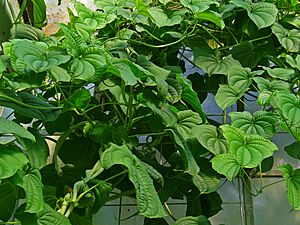Lesser yam facts for kids
Quick facts for kids Lesser yam |
|
|---|---|
 |
|
| Scientific classification | |
| Genus: |
Dioscorea
|
| Species: |
esculenta
|
The Dioscorea esculenta, often called the lesser yam, is a type of yam plant. It originally comes from Island Southeast Asia. Long ago, early Austronesian travelers carried it to places like Near Oceania and East Africa. People grow this plant mainly for its edible tubers. These tubers are like underground storage parts. The lesser yam's tubers are smaller than those of the more common Dioscorea alata. Also, this plant often has spines.
Contents
What People Call This Yam
This yam has many different names depending on where you are!
- In Vietnam, it is known as khoai từ or củ từ. People use it to make a sweet dessert called chè củ từ.
- In the Philippines, it is called tugi.
- In Cebuano, another language in the Philippines, it is known as apali.
- In parts of Kerala, Goa, and Maharashtra in India, you might hear it called nana kizhangu or nheruvalli kizhangu in Malayalam.
- In Goa, it's known as Kaate Kanaga. This name means "spiny yam" because the plant is a climber that needs support.
How People Started Growing Lesser Yams
The lesser yam is the second most important yam grown by Austronesian peoples. It's easy to prepare because, unlike some other yams, it doesn't need much processing to remove bitterness. However, its tubers are smaller than those of Dioscorea alata, and the plant itself can be spiny.
How Lesser Yams Spread
Like D. alata, the lesser yam was brought to Madagascar and the Comoros islands by Austronesian voyagers. From there, it spread to the East African coast. It also became a very important crop in Near Oceania. However, it did not reach the farthest islands of Polynesia, like Hawaii and New Zealand.
Ancient Discoveries of Lesser Yams
Scientists have found tiny starch grains from the lesser yam at old archaeological sites.
- In Viti Levu, Fiji, starch grains were found at Lapita culture sites. These date back about 3,050 to 2,500 years ago.
- Experts believe the Lapita culture introduced D. esculenta to New Guinea. They also brought new farming methods, like wet cultivation.
- Traces of D. esculenta have also been found in the Mé Auré Cave site in Moindou, New Caledonia. These remains are from about 2,700 to 1,800 years ago.
- Even in Guam, remains of D. esculenta have been discovered. These date to around 1031 CE.
Understanding the Lesser Yam's Name
The scientific name for the lesser yam is Dioscorea esculenta. It belongs to the genus Dioscorea, which includes all yams. The word esculenta in its name is Latin. It means "edible," which perfectly describes this plant's tasty roots!
What the Lesser Yam Looks Like
The lesser yam plant has thin, round stems. It also has large, black, compound spines that can be 2–4 cm long. Its leaves are soft and shaped like a heart. They are usually about 5–8 cm long and 6–8 cm wide.

